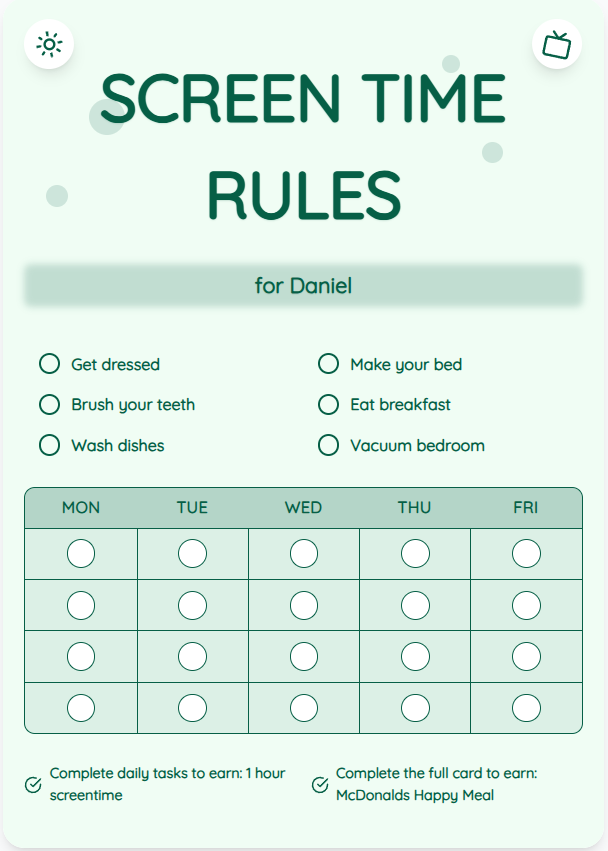Managing Screen Time on Linux: A Parent's Guide
As a parent, navigating the digital landscape can be daunting, especially when it comes to setting screen time limits for your children using Linux devices. Finding the right balance between technology usage and other activities is crucial for their development. In this guide, we'll explore actionable strategies and tips to help you manage screen time effectively while promoting healthy habits and family harmony.
See What Your Screen Time Chart Will Look Like
Here's an example of a beautiful, customizable screen time rules chart you can create for your family

Understanding the Impact of Screen Time on Child Development
Before implementing screen time limits on Linux, it's essential to understand how excessive screen time can affect your child's development. Research suggests that prolonged screen time can lead to issues such as sleep disturbances, decreased physical activity, and potential cognitive delays. By setting limits, you can help your child develop healthier habits and foster social interactions.
Practical Tips for Setting Screen Time Limits on Linux
1. Establish clear rules: Create a screen time schedule that outlines when and for how long your child can use Linux devices. 2. Use parental control tools: Leverage built-in features or third-party apps to set time limits and restrict access to certain content. 3. Encourage alternative activities: Introduce non-screen activities like outdoor play, reading, or creative projects to reduce reliance on digital devices. 4. Lead by example: Be a positive role model by demonstrating healthy screen time habits yourself.
Put These Tips Into Action
Create a custom chart to implement these strategies with your child
Utilizing Screen Time Charts for Effective Management
Screen time charts can be valuable tools for visualizing and tracking your child's screen time usage on Linux. By using a screen time chart generator like ScreenTimeRules.com, you can create customized schedules and monitor adherence to set limits. These charts provide a visual aid that helps children understand and follow the established rules.
Practical Tips for Success
- Set consistent screen time rules and communicate them clearly to your child.
- Encourage breaks during screen time sessions to prevent prolonged exposure.
- Involve your child in creating the screen time schedule to promote ownership and responsibility.
- Monitor your child's online activities and discuss internet safety regularly.
Frequently Asked Questions
How many hours of screen time is recommended for children?
The American Academy of Pediatrics recommends no more than 1 hour of screen time per day for children aged 2-5, and consistent limits for older children based on individual needs.
Are there any benefits to screen time for children?
While excessive screen time can have negative effects, educational and age-appropriate content can offer benefits like cognitive development, problem-solving skills, and exposure to new ideas.
How can I handle resistance from my child when enforcing screen time limits?
Consistency is key when setting and enforcing screen time limits. Explain the reasons behind the rules, offer incentives for compliance, and address any concerns or objections your child may have in a calm and understanding manner.
By implementing practical strategies and utilizing tools like screen time charts, you can effectively manage your child's screen time on Linux while promoting a healthy balance of digital usage and other activities. Visit ScreenTimeRules.com to create personalized screen time charts and start fostering positive screen time habits today.
Ready to Transform Your Family's Screen Time?
Join thousands of parents who have successfully managed screen time with our customizable charts.
